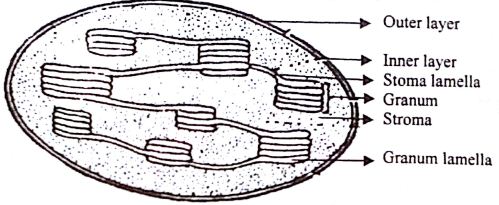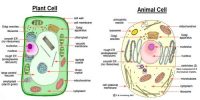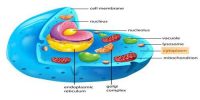Position:
The chloroplast is present in the green pans of the plant, especially in leaves. It is an organelle unique to plant cells that contains chlorophyll and is liable for enabling photosynthesis to happen so that plants can adapt sunlight into chemical energy. They are only present in photosynthetic cells like plant cells and algae. There are no chloroplasts in animal or bacterial cells.
Number:
One too many per cell. Each higher plant cell: 20 to 40. Example- Spirogyra. Each lower plant cell: Less than that of a higher plant chloroplast. Chlamydomonas contains only a single chloroplast.
Structure:
It may be of the following structures:
(a) Spiral chloroplast. Example- Spirogyra.
(b) Belt-shaped chloroplast. Example- Ulothrix.
(c) Cup-shaped chloroplast. Example- Chlamydomonas.
(d) Star-shaped chloroplast. Example- Zygnema.

Fig: Different parts of chloroplast (a simplified figure seen through the electron microscope)
Structure of chloroplast:
The structure of the chloroplast is very complicated. In a chloroplast, three parts are seen clearly when it is observed through the electron microscope
- Membrane
- Stroma
- Grana
Membrane: A chloroplast is covered with a two-layered membrane. It is composed of lipid and protein. Structurally it is similar to the plasma membrane. It has an inner and outer membrane with an empty intermediate space in between. Inside the chloroplast are stacks of thylakoids, called grana, as well as stroma, the dense fluid inside of the chloroplast.
Stroma: the hydrophilic matrix is covered with the membrane. This matrix is called Stroma Ribosome, osmophilic granules, etc. are present in the stroma.
Grans: Grana, which are sacs of coin-shaped double membranes called thylakoids are suspended in the stroma. The thylakoids contain chlorophyll and other pigments In each chloroplast there are usually about 40 to 60 grand and each granum may contain from 2 or 3 to more than 100 stacked thylakoids.
Two grans remaining side by side are linked together by some minute tubules, called stroma lamellae (sing lamella).
Chloroplasts found in higher plants are usually biconvex or planoconvex shaped. In dissimilar plants chloroplasts have dissimilar shapes, they vary from spheroid, filamentous saucer-shaped, discoid or ovoid-shaped. The size of the chloroplast also varies from species to species and it is stable for a given cell type. In higher plants, the average size of the chloroplast is 4-6 µ in diameter and 1-3 µ in thickness.
In the inner wall of each granum coin, there are some crystalline substances, called choantosome. Each choantosome contains chlorophyll-a, chlorophyll-b, carotin, xanthophyll, phospholipids, quinon, sulpholipid, and different enzymes. The space the chlorophyll fills is called the thylakoid space.













